How to Buy Land in Texas– A Step by Step Guide to Purchasing Rural Land
Congratulations! If you’re reading this article you must be interested in learning more about purchasing rural land.
Here I explain the steps of purchasing a raw tract of land such as a farm, ranch, or rural acreage and outline several tips along the way.
I’m a land agent in the state of Texas and a real estate investor who focuses solely on rural property so I’m familiar with how these transactions take place. I’ve wanted to create this article for some time because it’s the article I wish I would’ve had before I started the process learning on my own.
7 Primary Steps to Buying Land
- Securing Financing
- Finding right piece of land
- The Offer and Contract
- Land Inspection
- Rural Surveys
- Title
- Closing
Step 1— Securing Financing
If you’re going to pay cash you can move straight to step 2, otherwise it’s probably a good idea to secure financing prior to beginning your search.
Why secure financing before even finding the perfect place?
Right now the land market is as hot as I’ve ever seen it. It’s been getting progressively hotter since the mid 90’s and COVID set it on fire. Tracts are selling quickly, some within days and with multiple offers. In an environment like this there may not be time to secure financing after negotiating a contract.
Some markets are hotter than others, but I’ve personally seen buyers frustrated by missing out on their perfect place simply because they couldn’t line up financing quickly enough. And I’ve personally seen it several times….
The Texas Real Estate Center’s (TREC) promulgated contract (the form your agent will use) will allow a buyer SOME time to arrange financing but other offers may be taken more seriously if it’s already been arranged.
Just for reference of the land market, check out this chart of Texas rural land pricing trends created by the Texas A&M Real Estate Center.
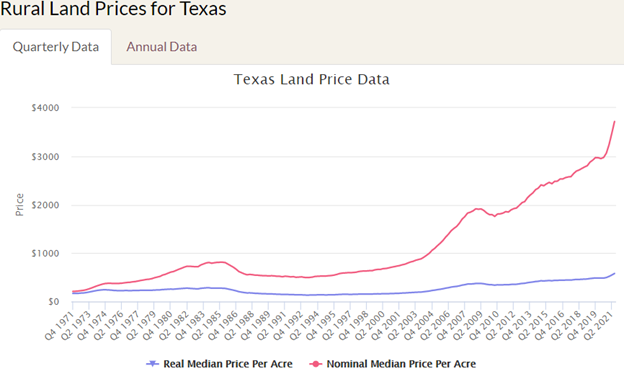
This graph shown from Texas A&M’s Real Estate Research Center shows land price trends.
Where to Get a Loan for Rural Land?
The best lender for purchasing raw or undeveloped land will likely be a member of the Farm Credit System. It was established by congress in 1916 to create liquidity in the agricultural land market much as the way Fannie Mae and Freddy Mac serve the residential home loan market. Today the Farm Credit system is a nationwide network of 71 customer owned financial institutions, 11 of which are in Texas.
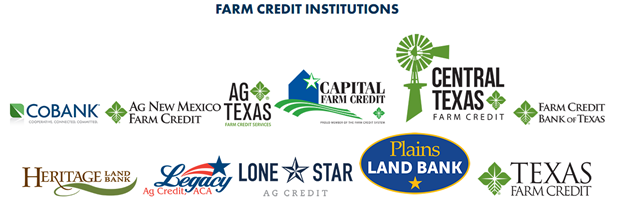
A member of the farm credit system will very likely be the best lender for you if you are purchasing over 10 acres of raw land with no improvements. These lenders specialize in raw land and agricultural financing so they are familiar with the nuances of a farm or ranch purchase. They will also have a number of resources at their disposal who are familiar with farm and ranch transactions.
Another good option can be to get a quote for financing from a local bank in a city near where you plan to purchase the property. These local institutions are familiar with the surrounding areas and are comfortable lending against land nearby. They will also have relationships with local surveyors and appraisers.
Big bank chains like Chase Bank or Wells Fargo are almost never a good option for purchasing raw or rural land. They simply have no existing system to deal with this type of transaction.
Step 2 – How to find and select the right piece of property for you
This is the fun part! You’ve probably already begun the search for that perfect property. There are a myriad of websites to visit and browse listings, each of which feature unique searching capabilities.
However, before you find our place…..
Get yourself a buyers agent!
This is the biggest “no brainer” as a land buyer. Unless you’ve purchased several tracts and are familiar with local pricing AND have access to a Multiple Listing Service (MLS) there is absolutely no reason to reach out directly to the a listing agent.
The listing agent is contractually obligated to serve the interest of the seller, not you. Moreover, they are incentivized to have you purchase one of the properties they are listing and not necessarily finding you the best property for you.
In most real estate transactions it is the SELLER who pays the commission which usually ranges around 5-6% for most properties. At closing, this commission is paid to the listing agent. If a buyer comes to the table represented by a buyer’s agent, the commission is usually split between the buyer’s agent and the listing agent. This is how the buyer’s agent is incentivized to help you find the right place for you.
Engaging an experienced land agent to represent you as the buyer that is familiar with rural land transactions and also comes with a deep understanding of the local land market WILL save you time and doesn’t cost you a penny.
I am an experienced land agent who help buyers find and that perfect piece of land. If you are seriously looking for rural land check out my information on the bottom of this article and reach out to me.
Best Land Listing Websites for Texas farms and ranches-
LandsofTexas – Has thousands of rural land listings in Texas. They have a mapping feature but not all of the listings on the site are searchable via the map.
HAR.com – Houston Association of Realtors (HAR) but has thousands of listings statewide and has the most powerful map based search application I’ve seen. I usually start here if looking in Texas.
Zillow – Also has a large network of land listings.
Step 3- The Offer and the Contract – How to make an offer on rural land
There is a lot to cover here so I’ll keep it high level for you here.
Markets vary with time, region, and even for segments of tract sizes within regions so the specifics here best covered with your buyer’s agent. Let’s go over a few things you should be aware of.
Even though markets vary and so do offers, what I see most often are offers starting about 10% below asking price and negotiating from there. Hot markets can result in multiple offers on a property very quickly and result in prices that are sometimes bid well above asking prices.
In other cases, properties may have access issues or an undesirable feature and sit on the market for several months often leaving sellers willing to negotiate lower prices. Understanding what is appropriate will be a job for you and your buyer’s agent to discuss.
Now let’s talk about the contract and how it can impact your offer.
As a licensed agent in Texas, I’m obligated to use a TREC promulgated contract for a rural land deal. TREC contracts have been used in thousands (if not millions) of land deals and cover almost anything you can imagine that would concern a real estate transaction. Below are some key points to these contracts and some things you can consider as you make your offer.
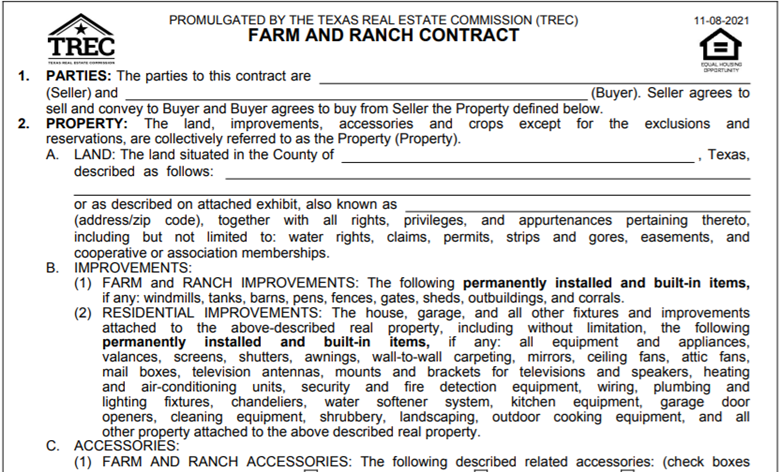
Some key points of a real estate contract and how they can affect a land deal.
Financing-
As I mentioned earlier, if you’re ready to buy it’s smart to go into a deal pre-approved as this will be a more compelling contract. If there are multiple offers a seller will often lean towards a cash offer first given a similar purchase price. In the absence of a cash offer however, a pre-approved letter submitted with your offer will be more compelling than an offer from someone that hasn’t gone through the process yet.
Minerals-
By default all mineral rights are transferred from the seller to the buyer with a TREC contract unless specifically reserved in the contract. In Texas, the mineral estate can be forever severed from the surface estate but remains the dominant estate. This means that the owners of the minerals have the right to use the surface estate to access their estate unless surface waivers have been signed. There is a lot to this subject and if this is something you wish to negotiate on during a deal make sure you engage an attorney who specializes in mineral rights.
Option period and pricing-
The option period will give you time to review the property and back out of the contract while only losing your “option money”. The shorter the option period or the more money you pay for the option the stronger the offer is. Some contracts go with no option period although that’s extremely rare. I typically see option periods range from 10-30 days unless there are a lot of potential issues, with 10 days being more common.
Survey-
I go into detail on survey below, but as it relates to the offer the biggest thing is to establish who will pay for a survey if a current survey doesn’t exist. I’ve seen this paid by buyers or by the sellers.
Closing costs-
Closing costs are the fees you pay your lender to generate the loan but can also include the cost of the title policy. These costs (generally 3-5% of the loan) can be covered by the seller if everyone agrees and it’s usually a bargaining chip during the negotiation process. Sometimes buyers agree to pay a higher price in exchange for getting closing costs paid for, this reduces out of pocket expenses for the buyer.
Closing Date-
This date depends on a number of factors, including time to get an appraisal and survey, turn around time for a title commitment, and the time it takes for your lender to go through the underwriting process. Sellers want to close as soon as possible so they can move on with their money. Offers with the shortest turn around and earliest closing dates are usually preferred. Closing dates generally range from 30-60 days from the date of the contract.
Step 4 – Property Inspection and what to look for-
After you and the seller agree on the terms and execute your contract, you’ll likely be inside of an option period. Use this time to fully evaluate the property and ensure it will meet your needs.
Unlike a home purchase there are no licensed land inspectors. For raw land it will be up to you, your buyers agent, and sometimes a qualified consultant to inspect the land during your option period and ensure it will meet your needs.
As a buyers agent I’ll pull soils data, flood plain data, vegetative production information, and connect the buyers with local wildlife biologists or agricultural experts to cover any necessary questions. I’ll also personally walk and ride the property with the buyer to see if there are any major concerns.
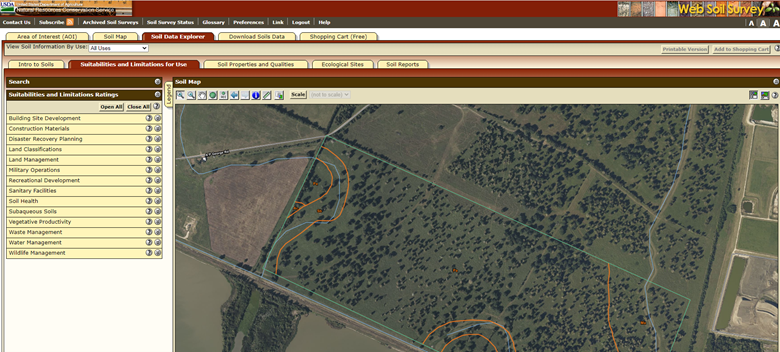
There are a number of free resources that you can leverage to find out even more about your new perspective property. First I would recommend reading the article I wrote called 10 Things You Need to Know Before Buying a Property. Then I would suggest checking out these free resources.
Free Resources for Land Buying
- Texas Railroad Commission GIS Site – Quickly find out about any pipelines and oil wells that exist on the property
- Web Soil Survey – Find out about the soils on the property, vegetative productivity for Gardens, Forestry, and Rangelands, as well as limiting factors for construction, buildings, ponds, and roads.
- FEMA Flood Maps – Check out this online mapping application that allows you to zoom into your perspective property and see flood plains.
- Texas Water Well Website – Learn more about any water wells on the property here. To learn even more about water wells in Texas check out our article called Water Wells in Texas.
Step 5 – Rural Land Surveys
This is a critical part of any raw land transaction as the survey defines exactly what you are purchasing.
Surveys on rural land are conducted differently than surveys conducted for residential homes. Boundaries for a home in a subdivision are defined in a lot and block system whereas a raw land boundaries are defined by metes and bounds. Metes and Bounds uses bearings from a point and distances to measure the circumference of the property in the legal description. A lot and block system has already been fully surveyed into several parcels, each with a lot number and a block they sit within.
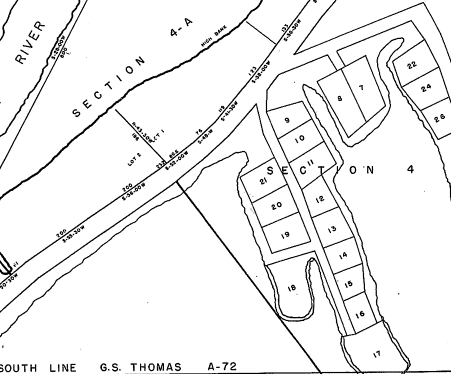
It’s nice when the property you are interested in comes with a recent survey but it’s rare unless it’s part of a group of properties that have been recently subdivided. I would highly suggest getting a survey done whether you are financing the property or not.
If you are financing the transaction, you will not be able to schedule closing date until the lender has received an updated and satisfactory survey. This makes sense as the survey ultimately defines what you are paying for. Without an updated survey, your title commitment will also come with additional exceptions to coverage.
Credentials for Rural Surveyors
Surveyors for rural or raw land must have be a Register Professional Land Surveyor (RPLS). This is a challenging accreditation and there are only a finite number around. During hot markets or in times with high transactions volumes credible surveyors can be booked out for weeks. I’ve had surveyors recently tell me they were 6 weeks out, which can push closings out to 45-60 days.
Step 6- Title Commitments in Texas
Although I put this as step 6 in the land buying process here, the title commitment begins early in the buying process. Immediately after the contract is executed it’s usually sent directly to a title company to receive a title commitment. It will typically takes 2-3 weeks to complete depending on several factors, and it’s usually completed as one of the last things you receive prior to closing.
For rural land you’ll want to use a title company located in the same county if possible as they are used to navigating the county record system.
What is a Title Commitment in Texas?
A Title Commitment is a commitment for title insurance, which simply provides the terms and conditions of how a final title policy will be issued. Title insurance offers protection for buyers and their lenders from a defined group of defects or errors to a title of the property.
One of it’s primary purposes is to make sure the people you are buying the property from actually own the land, and the people they bought it from owned it, and so on. It also insures that there are no tax liens and it’s not been used as collateral for loans. There are a number of other items it insures against but each policy can be as unique as the property.
Step 7 – Closing!
You’re finally there. At this point your lender will have checked all of the boxes we discussed in step 1. You will also have provided the title company with all required items in Schedule C of the title commitment.
Now the only thing left is to close. This means both you and the seller will sign over title, financing agreements, promissory notes, title commitments, and what seems to be about 50 other documents.
I hope this article was helpful! If you have questions or would like to discuss how I can represent you as your buyers agent please feel free to email me at Michael@LandAssociation.org
I look forward to hearing from you!
About the Author:
Michael Morrow is the founder of the Texas Landowner’s Association and a land agent in the state of Texas. He is dedicated to ensuring landowners have the resources, information, and platform they need to effectively accomplish their personal goals for their property. His undergraduate and graduate level studies at Texas A&M were focused around Rangeland Ecology and Wildlife Management. He’d love to help you with your next purchase or help take your property to market. You can reach him here by emailing Michael@LandAssociation.org

1 thought on “How to Buy Land in Texas– A Step by Step Guide to Purchasing Rural Land”
Comments are closed.